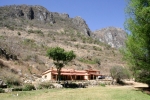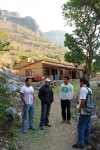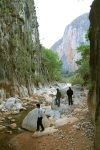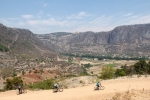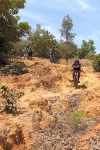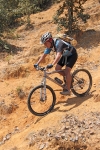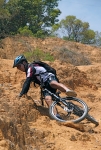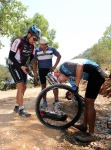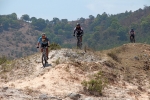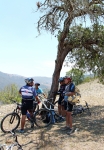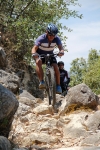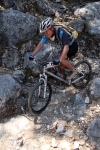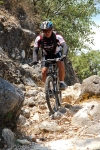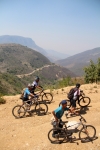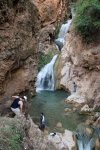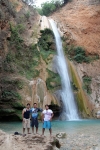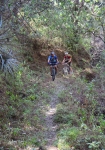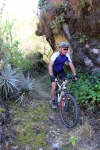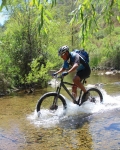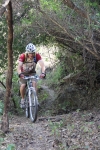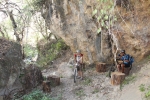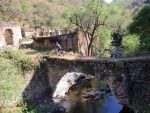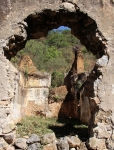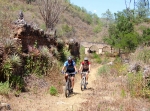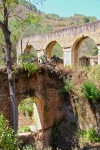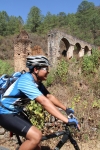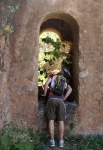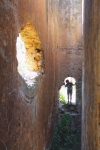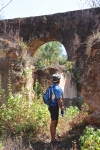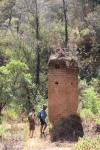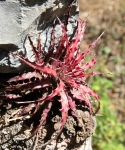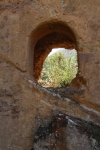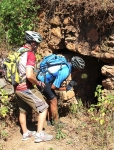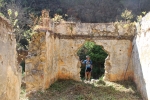The crew that manages the ecotourism camp at La Cumbre, in the mountains just off Hwy 175 a few miles north of Oaxaca city, have been busy making improvements this summer of 2015. They did some serious trail work to grade and widen the single track portion of the route used for annual mountain bike races there. And there is a new observation tower atop the Mirador that offers a stunning view of the surrounding countryside. These improvements follow the construction of a new kitchen and dining room two years ago. Kudos to those responsible for this work!
Category: Hiking
Countryside, Foothills, Hiking, Mountains, MTBing, Photos
Mountain Biking In Colorado
by Larry • • 0 Comments
Mountain bikers who live in Colorado are a lucky lot. As is the case in many of the western States in the U.S., a large part of Colorado’s territory — 35%, or over 23 million acres — is public land. These public lands include national parks, forests, wildlife refuges, monuments, wilderness areas and lands managed by the Bureau of Land Management. Most of these lands are owned and overseen by the federal government. But whether under the umbrella of federal, state or more local authority, these lands may be used by the public for recreation. Residents of Colorado spend millions of dollars of tax revenue every year to preserve, protect and improve their public land. In the mountains near Denver there are dozens of city, county and state parks where people may hike or ride mountain bikes. In most places, trails are well mapped and equipped with signs. Most trails are well maintained, either by governmental agencies or local volunteer groups. New trails are always being proposed and are generally built in a collaborative manner by local interest groups (i.e. mountain bike clubs) working in cooperation with government agencies. The result is a terrific network of trails which mountain bikers and all outdoor enthusiasts can enjoy.
Today’s outing was a ride in Golden Gate Canyon State Park in the mountains not far from Golden, Colorado, the western-most suburb of the Denver metro area. The loop ride on the Blue Grouse and Mule Deer trails covered 11.2 miles (18.0 kms), with an elevation gain and loss of 1500 feet (457 meters). The trailhead sits at an altitude of 8400 feet (2560 meters) and the highest point of the trail crossed the 9400 feet (2865 meter) mark. Nine members of the Rocky Mountain Bicycle Boys bike club took part. After completing the ride, the group stopped for lunch and liquid refreshments at a local brewery in Golden.
To view a map of the trail network at Golden Gate State Park, click here.
Hiking, Mountains, MTBing, Outing
Zapotrek – Responsible tourism in Oaxaca, Mexico
by Larry • • 0 Comments
Eric Ramirez is an enthusiastic young man with a passion for exploring the natural wonders of Oaxaca. He offers hiking excursions, bicycling tours, cultural tours, mezcal tours, eco-archeological tours and rock climbing. He speaks excellent English. Visit Eric’s web site at Zapotrek.com or contact him personally at eric@zapotrek.com or 951-257-7712
Countryside, Hiking, MTBing, Outing, Photos
Apoala
by Larry • • 0 Comments
Santiago Apoala is a very small (pop. 200) Mixtec village located in a deep, secluded valley 68 miles northwest of Oaxaca city. Its dramatic setting and some of the physical characteristics of the area make it a fine destination for hiking and mountain biking. The Mexican government has designated Apoala as a natural biosphere, and has constructed an ecotourism center there. The principal things of interest to visitors are the extremely narrow, vertiginous canyon that guards the northern approach to the village; the natural spring at the base of a cliff that gushes clear, frigid water year around; the various caves that riddle the nearby hillsides; and the series of scenic cascades and waterfalls created by the water flowing out of the valley and over yet another cliff. The highway between Nochixtlan and Apoala was paved in 2022, reducing the drive time from Oaxaca from 3.5 hours to just 2 hours.
Mountain bikers will find the area challenging, in part because trails are difficult to find and partly because of the technical obstacles of the terrain. Hiring a local guide to ride with you is strongly recommended — as is having a sturdy bike and being in good physical condition. Be sure to carry plenty of water and food, as you may spend a grueling day in the saddle with no opportunity to resupply. Also carry a decent supply of tools, tire repair kit and a spare tube.
Apoala es un pueblo de 200 habitantes en la Mixteca a 109 kilómetros al noreste de la Cuidad de Oaxaca. Su ubicación en un dramático paisaje lo hace un destino muy atractivo para hace paseos de “mountain biking” y para caminatas. Puesto que se necesitan tres horas y media para llegar a Apoala es mejor quesdarse dos días allá. El gobierno mexicano se ha designado a Apoala como “un biosfero natural” y ha construido un Centro de Ecoturismo. Para los visitantes los aspectos más interesantes son los barrancas estrechas y profundas que están al lado norte del pueblo, el manantial de aguas limpias y muy frías al fondo de un despeñadero, varias cuevas en las laderas, y una serie de cascadas que vienen del valle y caen de otro despeñadero.
Los que son ciclistas de las montanas encuentran el área un reto puesto que las sendas son difíciles de encontrar y los obstáculos del terreno. Se recomenda que los participantes contrate un guía local y tenga un bicicleta en óptima condición. Es importante tener consigo una buena cantidad de agua y comida dado que el viaje es agotatante y sin oportunidades de conseguir ni agua ni alimentos. Es aconsejable llevar herramientas para reparar llantas y un cámara de aire extra.
Countryside, GPS, Hiking, Mountains, MTBing, Photos
Cinco Señores Mine
by Larry • • 0 Comments
When people think of archeological ruins in Oaxaca, they picture ancient Indian cities, with palaces, temples, ball courts and such. There are other ruins, though, that date from the days of the Spanish conquistadores or more recent times.
It is recorded that the Aztec great speaker, Montezuma II, told Hernán Cortés that most of his gold came from Oaxaca state. Being the wily character that he was, Cortés arranged to have himself proclaimed the Marques de Valle, and so claimed most of Oaxaca state and a good bit of Vera Cruz state as his personal fiefdom. Then he – and the Spaniards who followed – set about searching for gold and silver. They found these mineral riches in the Sierra Norte mountains to the north of Oaxaca city, where they established mining operations. This bike ride explores the ruins of some of these mines in the valley of the Rio Papaloapam near the town of San Miguel Amatlan, one of the eight villages in the Pueblos Mancomunados that share their forest lands and promote eco-tourism.
The journey begins at the eco-tourism office in Amatlan, where some hand-drawn maps provide an overview of the area and show which roads lead to the old mines and the haciendas that serviced them. The GPS map below shows a loop that follows a dirt road out of town, up and over a ridge and down into the river valley in the direction of Yavesia. After pedaling 8.5 km (5.3 miles) the imposing ruins of one of the mine facilities appears in the valley below, and can be easily accessed by an old service road. From that point on it is easy to follow the singletrack trail that courses along the bank of the river, passing from one intriguing ruin to another, crossing over several stone bridges. As the photos below indicate, there is quite a lot to see. The most notable structures are the stone aqueducts and the imposing buildings that once housed water wheels (some vertical and others horizontal) that powered the mine facilities. The size and complexity of the installations are readily apparent from the crumbling walls and foundations still visible. Be sure to bring a camera!
The route described is a loop which covers 10.2 miles (16.4 km), the first half of which (the southern part of the loop) covers 5.28 miles on dirt roads leading to the ruins. Most of the climbing (1347 feet / 410.5 meters) and descending (1061 feet / 323.4 meters) happens here. Once you reach the ruins, the trail pretty much follows the river, descending gradually another 626 feet / 190.8 meters over the course of 3.3 miles (5.3 km) to the lowest point (6035 feet / 1839.5 meters in elevation). From there it is a moderate climb back up the hill to Amatlan (a gain of 502.5 feet / 153 meters) in 1.7 miles / 2.7 km.
You should allow 2 hours drive time to reach Amatlan from Oaxaca city.
The ruins can also be reached by riding out & back from Amatlan, using just the last half of the loop (the northern part) described. This may actually be preferred, as it eliminates the biggest of the climbs and because you will find each of the hacienda ruins along the way more dramatic than the one preceding.
Cuando la gente piensa en sitios arqueologicos en Oaxaca, se imaginan antiguas ciudades Indigenas, con palacios, templos, juegos de pelota como tal. Hay otras ruinas, sin embargo, que datan de la época de los conquistadores españoles o tiempos más recientes.
La historia menciona que el gran orador azteca, Moctezuma II, dijo a Hernán Cortés que la mayor parte de su oro provino de el estado de Oaxaca. Siendo astuto como el era, Cortés se autoproclamo Marqués de Valle, y reclamo para si mismo la mayor parte del Estado de Oaxaca, y un poco del estado de Veracruz como su feudo personal. Despues el – y los españoles que siguieron – se establecieron ahi en la búsqueda de oro y plata. Encontraron estas riquezas minerales en las montañas de la Sierra norte, al norte de la ciudad de Oaxaca, donde establecieron operaciones mineras. Este paseo en bicicleta explora las ruinas de algunas de estas minas en el valle del Río Papaloapam cerca de la ciudad de San Miguel Amatlán, uno de los ocho pueblos de la pueblos Mancomunados que comparten sus tierras forestales y promueven el ecoturismo.
El viaje comienza en la oficina de turismo ecológico en Amatlán, donde algunos mapas dibujados a mano proporcionan una visión general de la zona y muestran que los caminos conducen a las antiguas minas y las haciendas que les sirvieron a ellos. El mapa GPS muestra un bucle que sigue una camino de tierra fuera de la ciudad, y sobre una cresta y hacia abajo en el valle del río en dirección a Yavesia. Después de pedalear 8,5 kilometros (5,3 millas) de las imponentes ruinas de una de las instalaciones de la mina aparece abajo en el valle, y puede ser fácilmente se accesado por un camino antiguo de terraceria. a partir de ahí es fácil seguir las veredas que va a lo largo de la orilla del río, pasando de una ruina intrigante a otro, cruzando varios puentes de piedra. Como las fotos siguientes indican, hay mucho que ver. los edificios más notables son los acueductos de piedra y los imponentes edificios que una vez albergó las ruedas de agua (algunos vertical y otros horizontales) que alimentaba las instalaciones de la mina. El tamaño y la complejidad de las instalaciones son fácilmente evidentes a partir de las paredes se desmoronan y fundaciones todavía visibles. Asegúrese de llevar una cámara!
La ruta descrita es un bucle que cubre 10,2 millas (16,4 km), la primera mitad de los cuales (la parte sur del bucle) cubre 5,28 millas de caminos de tierra que conducen a las ruinas. La mayor parte de la escalada (1.347 pies / 410,5 metros) y descendente (1.061 pies / 323,4 metros) que pasa aquí. Una vez que se llega a las ruinas, el camino sigue más o menos el río, descendiendo poco a poco otros 626 pies / 190.8 metros a lo largo de 3,3 millas (5.3 kilómetros) al punto más bajo (6.035 pies / 1839.5 metros de altitud). a partir de ahí es una subida moderada de vuelta a la colina a Amatlán (una ganancia de 502,5 pies / 153 metros) de 1,7 millas / 2,7 kilometros.
Debes considerar 2 horas de manejo para llegar a tiempo a Amatlán desde la ciudad de Oaxaca.
Se puede llegar a las ruinas también, utilizando sólo la última mitad del bucle (la parte norte) descrito. En realidad, esto puede ser preferible, ya que elimina la mayor de las subidas y porque se encuentra cada uno de las ruinas de la hacienda a lo largo de la forma más dramática que la anterior.
